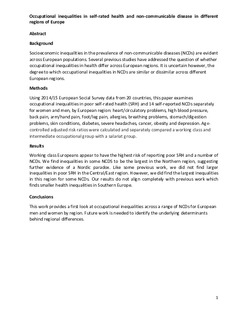| dc.contributor.author | McNamara, Courtney L. | |
| dc.contributor.author | Toch-Marquardt, Marlen | |
| dc.contributor.author | Balaj, Mirza | |
| dc.contributor.author | Reibling, Nadine | |
| dc.contributor.author | Eikemo, Terje Andreas | |
| dc.contributor.author | Bambra, Clare | |
| dc.date.accessioned | 2017-11-03T14:08:01Z | |
| dc.date.available | 2017-11-03T14:08:01Z | |
| dc.date.created | 2017-03-01T13:31:01Z | |
| dc.date.issued | 2017 | |
| dc.identifier.citation | European Journal of Public Health. 2017, 27 27-33. | nb_NO |
| dc.identifier.issn | 1101-1262 | |
| dc.identifier.uri | http://hdl.handle.net/11250/2464041 | |
| dc.description.abstract | Background: Socioeconomic inequalities in the prevalence of non-communicable diseases (NCDs) are evident across European populations. Several previous studies have addressed the question of whether occupational inequalities in health differ across European regions. It is uncertain however, the degree to which occupational inequalities in NCDs are similar or dissimilar across different European regions.
Methods: Using 2014 European Social Survey data from 20 countries, this article examines occupational inequalities in poor self-rated health (SRH) and 14 self-reported NCDs separately for women and men, by European region: heart/circulatory problems, high blood pressure, back pain, arm/hand pain, foot/leg pain, allergies, breathing problems, stomach/digestion problems, skin conditions, diabetes, severe headaches, cancer, obesity and depression. Age-controlled adjusted risk ratios were calculated and separately compared a working class and intermediate occupational group with a salariat group.
Results: Working class Europeans appear to have the highest risk of reporting poor SRH and a number of NCDs. We find inequalities in some NCDS to be the largest in the Northern region, suggesting further evidence of a Nordic paradox. Like some previous work, we did not find larger inequalities in poor SRH in the Central/East region. However, we did find the largest inequalities in this region for some NCDs. Our results do not align completely with previous work which finds smaller health inequalities in Southern Europe.
Conclusions: This work provides a first look at occupational inequalities across a range of NCDs for European men and women by region. Future work is needed to identify the underlying determinants behind regional differences. | nb_NO |
| dc.language.iso | eng | nb_NO |
| dc.publisher | Oxford University Press (OUP) | nb_NO |
| dc.title | Occupational inequalities in self-rated health and non-communicable diseases in different regions of Europe: findings from the European Social Survey (2014) special module on the social determinants of health. | nb_NO |
| dc.type | Journal article | nb_NO |
| dc.description.version | submittedVersion | nb_NO |
| dc.source.pagenumber | 27-33 | nb_NO |
| dc.source.volume | 27 | nb_NO |
| dc.source.journal | European Journal of Public Health | nb_NO |
| dc.identifier.doi | 10.1093/eurpub/ckw223 | |
| dc.identifier.cristin | 1455001 | |
| dc.relation.project | Norges forskningsråd: 228694 | nb_NO |
| dc.description.localcode | © 2017. This is the authors' manuscript to the article. This article has been accepted for publication in [European Journal of Public Health] Published by Oxford University Press. | nb_NO |
| cristin.unitcode | 194,67,25,0 | |
| cristin.unitname | Institutt for sosiologi og statsvitenskap | |
| cristin.ispublished | true | |
| cristin.fulltext | preprint | |
| cristin.qualitycode | 1 | |
